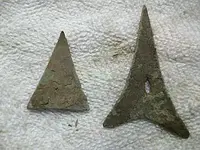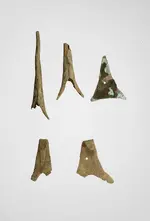paleomaxx
Hero Member
- Joined
- Aug 14, 2016
- Messages
- 841
- Reaction score
- 6,888
- Golden Thread
- 6
- Location
- Upstate, NY
- 🥇 Banner finds
- 6
- Detector(s) used
- Deus XP
- Primary Interest:
- All Treasure Hunting
This will be a very hard hunt for me to top! It was actually a few days ago, but it's taken me this long to finish preserving the multitude of pewter pieces and I couldn't bear to not post these finds in their entirety. Be warned, there are going to be a lot of photos!
The site itself is an enigma, and I'll explain more later on, but suffice to say I had no idea what I was about to stumble upon. All of these finds were within a 10 foot by 12 foot area and most were in a 6 foot by 6 foot square. Everything was so tightly grouped that I would pull a target out of a hole and swing over it again and get a second target a few inches to the side. Two spoons and one shoe buckle were in the same (extra large) plug!
This is the compilation shot of the hunt:
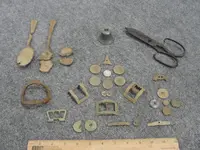
The coin spill was incredible, but I didn't even realize it was a spill until I finished digging and realized that all of the coppers were within a 1 foot circle. By the end I had dug two Connecticut coppers, a 1770 King George III, one slick, and one quarter sized copper I blieve is an Irish evasion token.
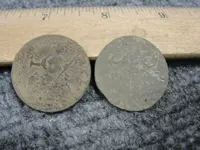
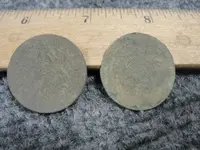
Above are the two Conn coppers. One is full thickness and the other very thin so I imagine the thin one is a later date (1787-1788) when they were minting them on lighter planchettes. It unfortunate that the site is literally next to a stream so the moist ground did a number on the copper. Fortunately all but one were identifiable, but I could only get a date off the KGIII.
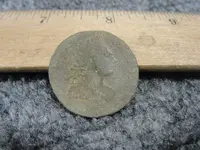
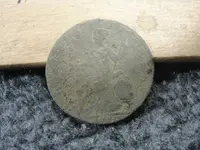
It's actually a nice KGIII and before the ground action probably AU.
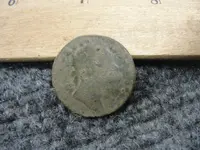
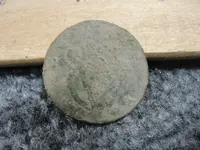
Above is the smallest copper which was a mere 1 inch below the surface which I think protected it from most of the water action. Its slick, but not terribly corroded. The back has the faintest outline of the Irish harp and the lettering around the bust seems to be "Georgius III" From my research I think it's an Irish evasion token which might account for the small size.
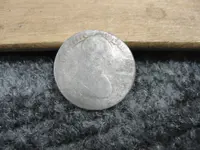
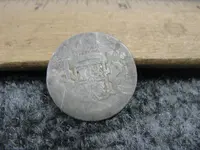
There was one piece of silver during my hunt, and it's my first Spanish silver from the reign of Charles IIII! It's well worn, but the date seems to be 1801. It was 4 feet from the main spill though, so I don't think it's directly related.
This hunt also produced an extraordinary number of complete Artois shoe buckles, including a matched set of three which is incredible.
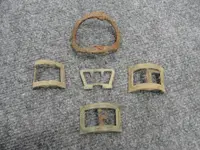
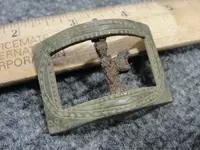
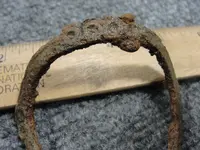
One of the brass buckles is bent, but the other two are in great shape and one even has part of the iron chape intact! From the detail, it's clear someone spent a lot of time carving each one of these. Also I'm particularly proud of myself for recovering the large pewter buckle without damage. Those high-curved buckles are insanely delicate and if I'd even torqued the plug the wrong way it would have shattered. I ended up soaking it in Elmer's glue, but it seems to be stable now and some of the etchings even survived!
The pewter spoons also took repeated coats of glue to stabilize and clearly didn't fare too well in the ground, but to find almost full rat tail spoons was completely unexpected!
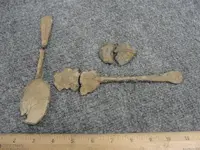
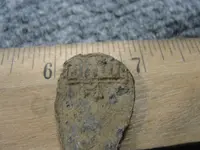
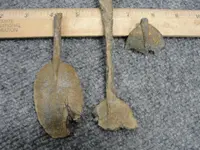
The two most complete ones were in the same hole, but the fragments of the third (or possible more) were scattered all about the site. One seems to have a maker's mark or design at the tip of the handle on the bottom side, but strangely the other does not have the mark.
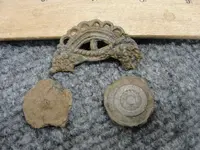
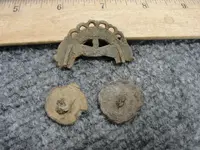
These are a few more pieces of pewter I managed to save from disintegration. Two buttons, one of which has nice detail left in the bullseye design. The ornate piece looks like a fragment of what must have been a stunning buckle, but this was the only part I recovered.
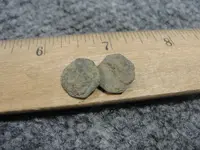
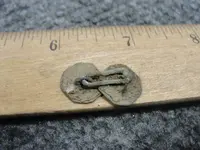
As you can see I finally found my own set of colonial cufflinks! It's nice to cross something off the bucket list among all the other treasures.
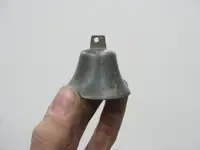
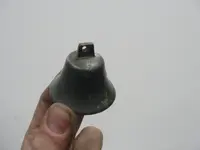
The bell is fully intact, and somewhat plainer than the ones I usually find (no engravings or etchings) which makes me think it could also date to the late 1700's. It's just amazing that there's absolutely no trace of corrosion inside or out.
Despite all the amazing targets I dug, an iron relic is one of the favorites:
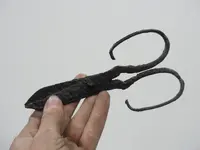
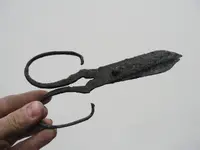
This pair of scissors was in the middle of the coin spill and actually right below one of the coins. I tumbled it to remove the crust and did a boiling wax treatment to seal them and I'm quite pleased with the results. It's such a simple artifact, but to hold almost 250 year old scissors is amazing.
Last is my absolute favorite find: a brass kettle point!
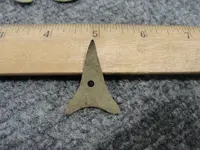
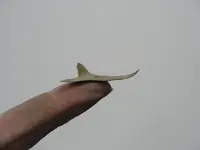
One of the reason's I'm so grateful for Treasurenet is because in reading fellow detectorist's postings, I actually know what artifacts like this are when I stumble across them. I have no idea how it came to be were I found it (in the middle of late 18th century artifacts when it's likely mid 17th), but the design is unmistakable. I'm a good ways away from Connecticut so it's possible that this point meandered for decades until it was finally lost in New York. It's also possible it was a souvenir held onto for years after the King Philips war. It's impossible to know, but the possibilities are what's fun about this piece.
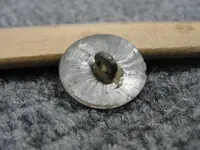
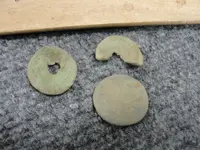
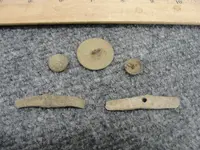
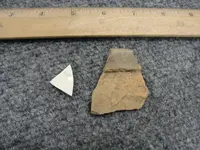
There were a few other odds and ends, but surprisingly few buttons considering the other relics dug. I love the tombac with the drilled shank because of how the toolmarks on the back look. A little lemon juice and it shined right up! I also found what appear to be two coins formed into makeshift washers. If that's the case they were hammered well past the point of identifying them.
Despite all of the artifacts recovered, I'm still not sure what this site actually was. It's adjacent to a foundation hole that I've detected for over a year now, but the small number of recoveries around the cellar are exclusively 1810's to 1860's and I was getting the distinct sense that it was a barn or mill; not a single colonial piece until this hunt. And what's also interesting is that through all of the plugs I dug to get these relics, only two small fragments of pottery were found (the two in the photo above) and no clay pipe stems. I gridded the area all around this patch and found absolutely nothing. Up the slope behind it, nothing. The hillside to the left, nothing. Even into the riverbank there were only a few modern bullets. Whatever this site was it was restricted to little more than a campfire circle of space.
Here's a sketch of the surrounding features:
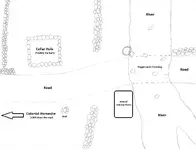
This could have been a campsite that travelers used after fording the stream or even a spot to dry off if they capsized their carriage. I suppose it could also have been a little trading post, but I would think that there would be more relics scattered about. I'll be hunting this area more in the coming weeks so hopefully I turn up additional relics, but this will be a hard act to follow!
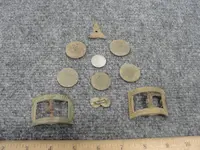
The site itself is an enigma, and I'll explain more later on, but suffice to say I had no idea what I was about to stumble upon. All of these finds were within a 10 foot by 12 foot area and most were in a 6 foot by 6 foot square. Everything was so tightly grouped that I would pull a target out of a hole and swing over it again and get a second target a few inches to the side. Two spoons and one shoe buckle were in the same (extra large) plug!
This is the compilation shot of the hunt:

The coin spill was incredible, but I didn't even realize it was a spill until I finished digging and realized that all of the coppers were within a 1 foot circle. By the end I had dug two Connecticut coppers, a 1770 King George III, one slick, and one quarter sized copper I blieve is an Irish evasion token.


Above are the two Conn coppers. One is full thickness and the other very thin so I imagine the thin one is a later date (1787-1788) when they were minting them on lighter planchettes. It unfortunate that the site is literally next to a stream so the moist ground did a number on the copper. Fortunately all but one were identifiable, but I could only get a date off the KGIII.


It's actually a nice KGIII and before the ground action probably AU.


Above is the smallest copper which was a mere 1 inch below the surface which I think protected it from most of the water action. Its slick, but not terribly corroded. The back has the faintest outline of the Irish harp and the lettering around the bust seems to be "Georgius III" From my research I think it's an Irish evasion token which might account for the small size.


There was one piece of silver during my hunt, and it's my first Spanish silver from the reign of Charles IIII! It's well worn, but the date seems to be 1801. It was 4 feet from the main spill though, so I don't think it's directly related.
This hunt also produced an extraordinary number of complete Artois shoe buckles, including a matched set of three which is incredible.



One of the brass buckles is bent, but the other two are in great shape and one even has part of the iron chape intact! From the detail, it's clear someone spent a lot of time carving each one of these. Also I'm particularly proud of myself for recovering the large pewter buckle without damage. Those high-curved buckles are insanely delicate and if I'd even torqued the plug the wrong way it would have shattered. I ended up soaking it in Elmer's glue, but it seems to be stable now and some of the etchings even survived!
The pewter spoons also took repeated coats of glue to stabilize and clearly didn't fare too well in the ground, but to find almost full rat tail spoons was completely unexpected!



The two most complete ones were in the same hole, but the fragments of the third (or possible more) were scattered all about the site. One seems to have a maker's mark or design at the tip of the handle on the bottom side, but strangely the other does not have the mark.


These are a few more pieces of pewter I managed to save from disintegration. Two buttons, one of which has nice detail left in the bullseye design. The ornate piece looks like a fragment of what must have been a stunning buckle, but this was the only part I recovered.


As you can see I finally found my own set of colonial cufflinks! It's nice to cross something off the bucket list among all the other treasures.



The bell is fully intact, and somewhat plainer than the ones I usually find (no engravings or etchings) which makes me think it could also date to the late 1700's. It's just amazing that there's absolutely no trace of corrosion inside or out.
Despite all the amazing targets I dug, an iron relic is one of the favorites:


This pair of scissors was in the middle of the coin spill and actually right below one of the coins. I tumbled it to remove the crust and did a boiling wax treatment to seal them and I'm quite pleased with the results. It's such a simple artifact, but to hold almost 250 year old scissors is amazing.
Last is my absolute favorite find: a brass kettle point!


One of the reason's I'm so grateful for Treasurenet is because in reading fellow detectorist's postings, I actually know what artifacts like this are when I stumble across them. I have no idea how it came to be were I found it (in the middle of late 18th century artifacts when it's likely mid 17th), but the design is unmistakable. I'm a good ways away from Connecticut so it's possible that this point meandered for decades until it was finally lost in New York. It's also possible it was a souvenir held onto for years after the King Philips war. It's impossible to know, but the possibilities are what's fun about this piece.




There were a few other odds and ends, but surprisingly few buttons considering the other relics dug. I love the tombac with the drilled shank because of how the toolmarks on the back look. A little lemon juice and it shined right up! I also found what appear to be two coins formed into makeshift washers. If that's the case they were hammered well past the point of identifying them.
Despite all of the artifacts recovered, I'm still not sure what this site actually was. It's adjacent to a foundation hole that I've detected for over a year now, but the small number of recoveries around the cellar are exclusively 1810's to 1860's and I was getting the distinct sense that it was a barn or mill; not a single colonial piece until this hunt. And what's also interesting is that through all of the plugs I dug to get these relics, only two small fragments of pottery were found (the two in the photo above) and no clay pipe stems. I gridded the area all around this patch and found absolutely nothing. Up the slope behind it, nothing. The hillside to the left, nothing. Even into the riverbank there were only a few modern bullets. Whatever this site was it was restricted to little more than a campfire circle of space.
Here's a sketch of the surrounding features:

This could have been a campsite that travelers used after fording the stream or even a spot to dry off if they capsized their carriage. I suppose it could also have been a little trading post, but I would think that there would be more relics scattered about. I'll be hunting this area more in the coming weeks so hopefully I turn up additional relics, but this will be a hard act to follow!

Upvote
54




